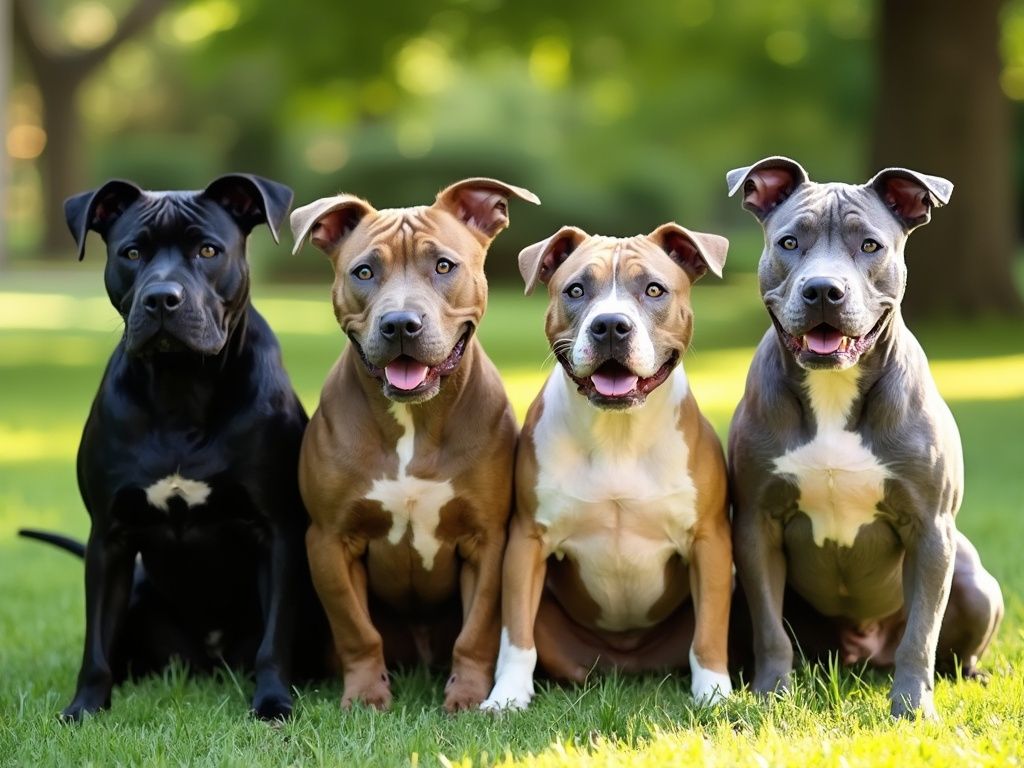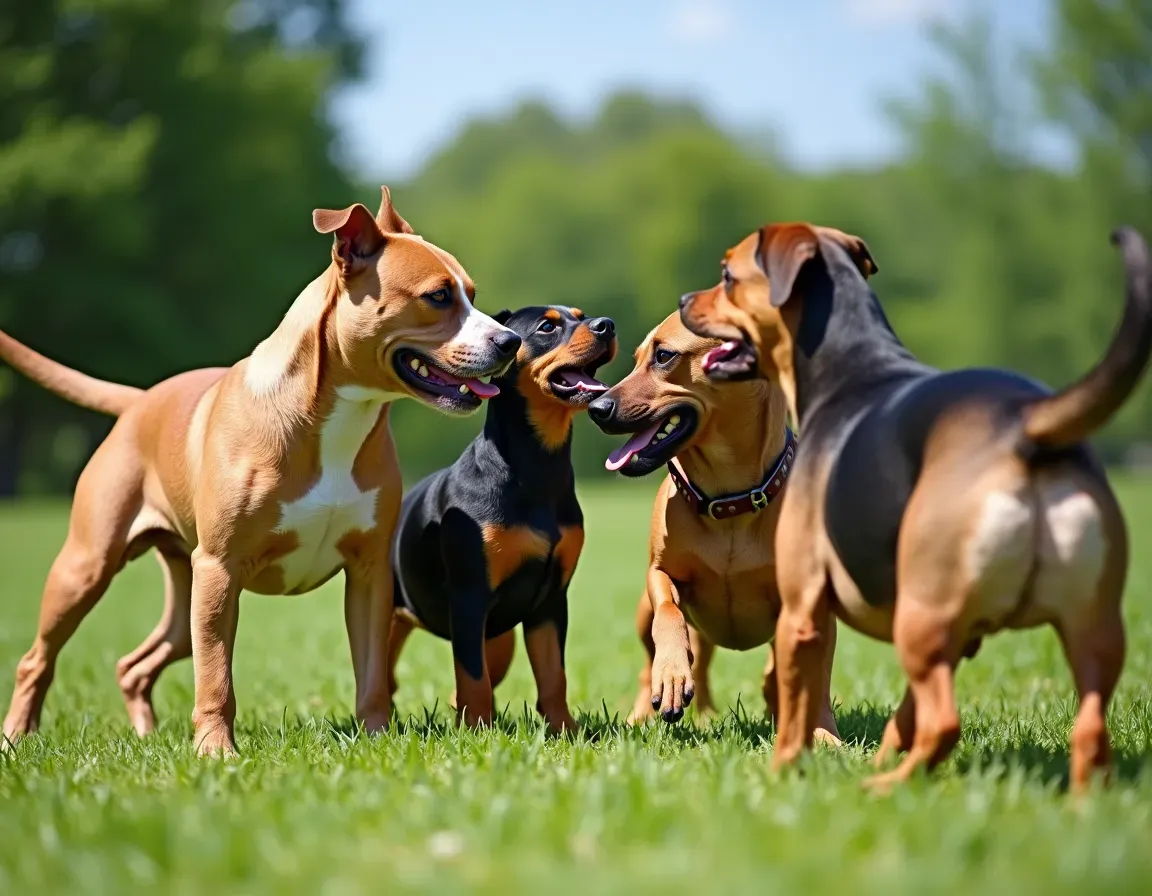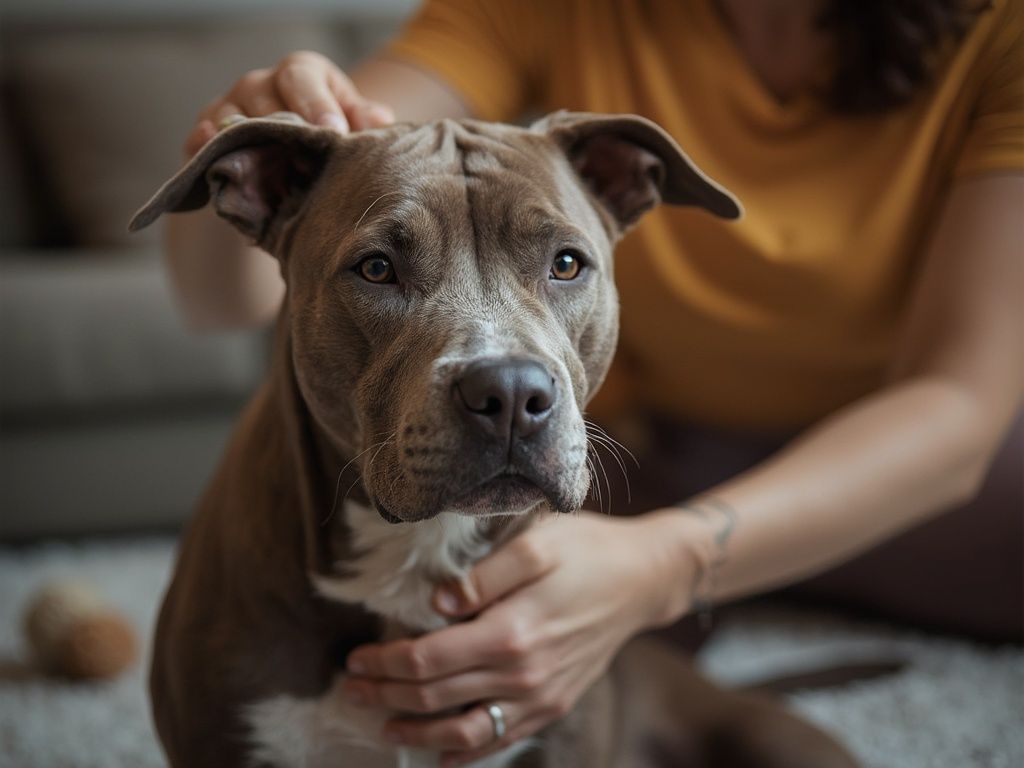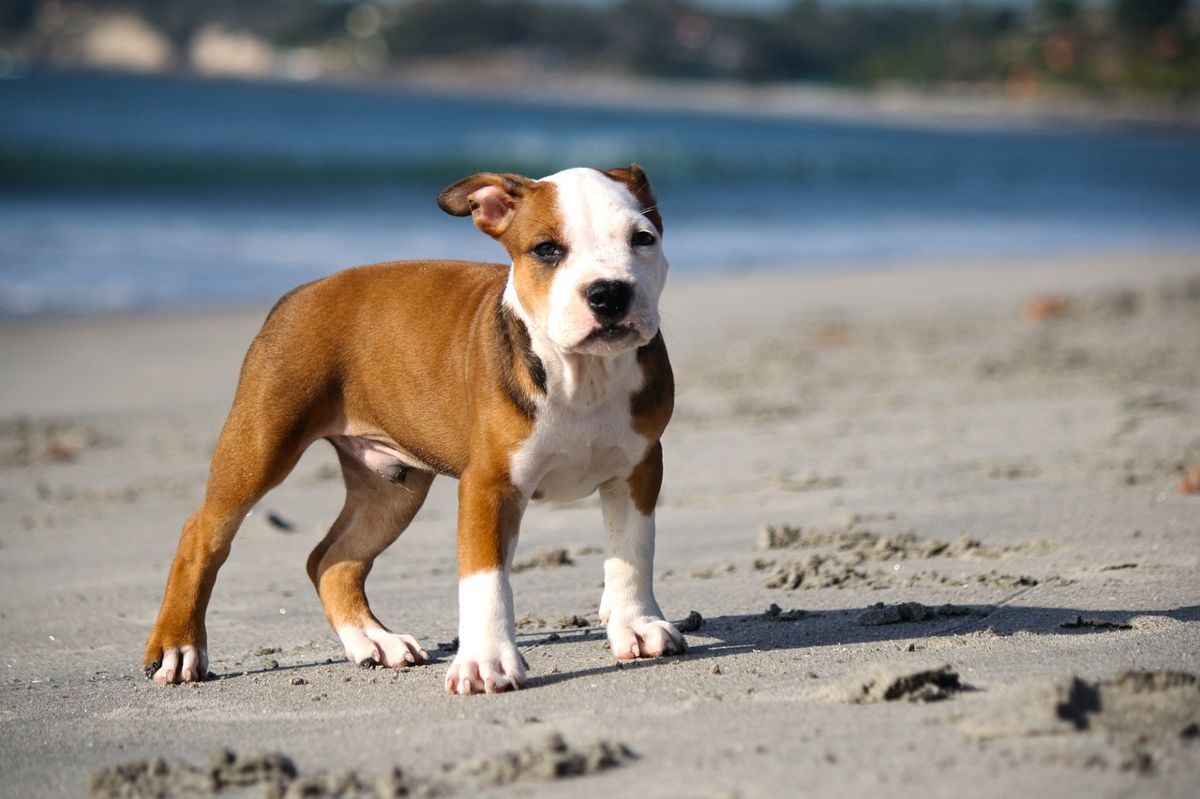The Pitbull is a breed that is sometimes loved for its loyalty and dynamism, and sometimes feared due to its controversial reputation. It is classified as a dangerous dog in certain states in the United States, as explained by Animal Law. However, this dog is much more complex than it seems!
In reality, the Pitbull is an excellent companion when well-trained and socialized. Some even say they were nanny dogs due to their protective behavior with children. So let’s discover together all the characteristics of this often misunderstood breed!
Origins of the Pitbull #
The Pitbull, also known as the American Pit Bull Terrier, has its origins in England in the 19th century. It descends from dogs used for bull and dog fighting, a common practice at the time.
When these fights were banned, these dogs were bred to become family companions, especially in America, where they were recognized for their courage and loyalty. Pitbulls were also used as farm dogs, for hunting and guarding. This reinforced their reputation as versatile and robust dogs.
Physical Characteristics of the Pitbull #
Pitbulls have an athletic and muscular appearance, reflecting their strength and energy.
Size and Weight #
The Pitbull is a medium-sized dog but rather heavy due to its developed muscles.
| Gender | Height | Weight |
|---|---|---|
| Male | 17.7-20.9 inches | 35-66 pounds |
| Female | 16.9-19.7 inches | 35-66 pounds |
Coat Color #
The Pitbull’s coat is short, smooth, and easy to maintain. In terms of color, the list is quite extensive:
- Black
- White
- Fawn
- Blue
- Red
These classic colors also come in variations with spots or brindle patterns.

Specifics #
The Pitbull has a powerful jaw and a developed musculature, contributing to its reputation as a strong dog. Despite this, its expressive gaze and its upright or semi-upright ears give it a lively and alert appearance.
And contrary to some misconceptions, the Pitbull does not have a “locking” jaw: this is a widespread but unfounded myth.
Behavior of the Pitbull #
The behavior of the Pitbull varies depending on its training and socialization. Often perceived as a dog with a strong temperament, it can, however, be a very loyal and affectionate companion when properly guided.
Behavior with Children #
Pitbulls, when well socialized, can be devoted and protective companions for children. As mentioned earlier, they were once called nanny dogs for their patience and ability to watch over the younger family members. However, due to their strength, it is important to always supervise interactions between a Pitbull and children to avoid any accidents.
Behavior with Other Animals #
The behavior of the Pitbull with other animals largely depends on its socialization from a young age. They can get along well with other dogs or pets if they have been positively exposed to them. However, it is important to remember that this breed can have a high prey drive, which requires proper guidance to avoid aggressive behaviors towards small animals.
Health of the Pitbull #
Life Expectancy #
The Pitbull has a life expectancy of about 12 to 16 years, which is relatively long for a dog of its size. This largely depends on the quality of its diet, regular veterinary care, and its level of physical exercise.
Common Diseases #
Although Pitbulls are generally robust, they can be prone to certain diseases such as hip dysplasia, skin allergies, and heart problems. It is recommended to have regular veterinary check-ups to monitor the onset of these conditions.
| Disease | Description | Frequency |
|---|---|---|
| Skin Allergies | Allergic reactions to certain allergens, often manifested by itching | High |
| Hip Dysplasia | Malformation of the hip joint, causing pain and limping | Medium |
| Hypothyroidism | Dysfunction of the thyroid gland causing fatigue and weight gain | Medium |
| Cataracts | Clouding of the lens, which can lead to vision loss | Medium |
| Deafness | Hearing loss, more common in dogs with white coats | Low |
| Heart Problems | Malformations or heart failures that can affect the heart rate | Low |
Training the Pitbull #
Training the Pitbull is crucial to making it a balanced and sociable dog. This intelligent and energetic breed responds well to training if it is adapted. A rigorous yet kind education is necessary to channel its energy and ensure harmonious coexistence.
✔️ Positive Training Methods #
Pitbulls respond particularly well to training methods based on positive reinforcement, such as treats or verbal praise. Consistent and non-violent training builds the dog’s confidence and creates a bond of complicity.
- Use rewards to reinforce desired behaviors.
- Avoid any form of physical punishment, which could generate mistrust or aggression.
- Work on short sessions (5-10 minutes) to maintain the dog’s attention.
✔️ Importance of Early Socialization #
Early socialization is crucial for the Pitbull, as it helps avoid undesirable behaviors such as aggression towards other animals or humans. Here are some tips for properly socializing a Pitbull:
- Participate in puppy socialization classes.
- Expose the puppy to different situations, people, and environments.
- Encourage positive interactions with other animals.

✔️ House Training #
House training the Pitbull is done like for most dogs. It is important to start early using a regular routine and praising the puppy when it goes to the bathroom in the right place. A few tips:
- Establish regular outing times (morning, after meals, evening).
- Reward immediately after the puppy has gone outside.
- Do not punish in case of an accident, but clean up without drawing attention.
✔️ Teaching Basic Commands #
Pitbulls quickly learn basic commands like “sit,” “down,” and “heel.” These commands are essential for establishing a relationship of obedience and mutual respect. Here are the main commands to teach:
- Sit: Ideal for calming the dog and making it wait.
- Down: Helps control the dog in stressful situations.
- Heel: Useful during walks to prevent pulling on the leash.
❌ How to Manage Undesirable Behaviors of the Pitbull #
Pitbulls can sometimes exhibit undesirable behaviors such as biting or destroying objects. It is essential to identify these behaviors early and respond with appropriate solutions:
- Provide interactive toys to channel energy.
- Ignore undesirable behaviors to avoid reinforcing negative attention.
- Use commands to redirect the dog towards appropriate behavior.
Examples of Training Exercises #
Pitbulls, by their active nature, need regular physical exercise to stay healthy. Here are some activity ideas:
- Frisbee or ball games to stimulate their hunting instinct.
- Hiking or running to expend their energy.
- Agility sessions to work on their agility and obedience.
Character and Lifestyle of the Pitbull #
Despite its reputation as an aggressive dog, the Pitbull can be affectionate, loyal, and protective. Its lifestyle and behavior largely depend on the training it receives and the environment in which it evolves.
Physical Activity and Exercise #
The Pitbull is an energetic dog that requires a good amount of daily exercise to avoid boredom and destructive behaviors. An hour of activity per day is recommended to maintain its physical and mental balance.
To help you manage these activity moments, devices like Minitailz from Invoxia keep you informed about the time spent exercising.
Indoor Character #
Indoors, the Pitbull can be calm and affectionate, provided it has been properly exercised. They particularly enjoy being close to their owners and can be very cuddly!
Character with Family and Other Animals #
The Pitbull, despite sometimes having a bad reputation, is generally an exceptionally loyal family companion. When well-raised, they are protective without being aggressive. With other animals, proper introduction and socialization are necessary.
Living Environment #
The Pitbull adapts well to different environments, whether it is a house with a garden or an apartment, as long as it receives enough attention and daily exercise.
Care and Hygiene of the Pitbull #
Brushing and Bathing #
The Pitbull’s short coat requires little brushing. A weekly brushing is usually sufficient to remove dead hair and keep the coat shiny.
- Brushing Frequency: Once a week with a soft brush.
- Bathing: A bath every 2 to 3 months is recommended, unless it gets dirty. Use a gentle shampoo suitable for dogs to avoid skin irritations.

Teeth Cleaning #
Like all breeds, dental hygiene is important for the Pitbull. Regular teeth brushing helps prevent tartar buildup and periodontal disease. Aim for 2 to 3 brushings per week, using a specific toothpaste for dogs.
There are also alternatives in chew toys or dental sticks, which help maintain healthy teeth.
Ear Care #
Pitbulls have semi-erect ears that require regular maintenance to avoid infections. It is recommended to check and clean the ears weekly. For this, use an ear cleaning product suitable for dogs and a soft cotton ball, and never insert a cotton swab into the ear canal.
Nail Care #
The Pitbull’s nails should be trimmed regularly, about every 4 to 6 weeks, to avoid pain and deformities.
- Method: Use a dog nail clipper and only cut the transparent part of the nail.
- Tip: Get the dog used to this routine from a young age so it feels comfortable.
Diet #
The Pitbull’s diet should be balanced and suited to its activity level. An active adult Pitbull will need a protein-rich diet to maintain its muscle mass.
- Amount: About 2 to 3 cups of high-quality kibble per day, divided into two meals.
- Supplements: Depending on needs, fatty acid supplements (like fish oil) can be added to promote skin and coat health.
- Avoid: Foods high in carbohydrates or table scraps, which can lead to overweight or digestive issues. Also, be cautious of certain foods that can be toxic to the Pitbull and dogs in general.
Adoption and Cost of the Pitbull #
How much does it cost to adopt a Pitbull? #
The price of a Pitbull varies depending on the animal’s origin, the breeder, or the animal protection association. Here is an estimate of the costs:
- In a shelter: Between $160 and $320, depending on the veterinary care already provided (spaying/neutering, vaccinations, etc.).
- From a breeder: Between $880 and $1,600, depending on the lineage and guarantees provided (health tests, pedigree).
Long-term Costs #
Owning a Pitbull involves regular costs. Here is an estimate of the annual expenses for a Pitbull:
- Food: $440 to $880 per year, depending on the quality of kibble or homemade food.
- Veterinary Care: About $330 to $550 per year for consultations, vaccines, and deworming. In case of health issues (dysplasia, allergies), these costs can increase.
- Accessories: About $110 to $220 per year for toys, collars, leashes, and other accessories.
- Health Insurance: About $15 to $40 per month, depending on the coverage chosen (accidents, illnesses, etc.).

The Pitbull is a breed with many facets, often misunderstood. Loyal, protective, and dynamic, it can be a wonderful companion when well-trained and socialized.
If you are considering adopting a Pitbull, it is essential to commit to providing it with appropriate training, attention, and an environment that allows it to expend its energy. With the right care, the Pitbull will reward you with its unwavering loyalty and sincere affection, making it a valuable member of your family!

